Calla Lilies have a long bloom period, and put on a fabulous show. When the blooming is done, it's time to look at calla lily care after blooming. With the right care, your calla lily rhizomes will slowly enter their dormant period, and then continue to grow on for another blooming cycle.
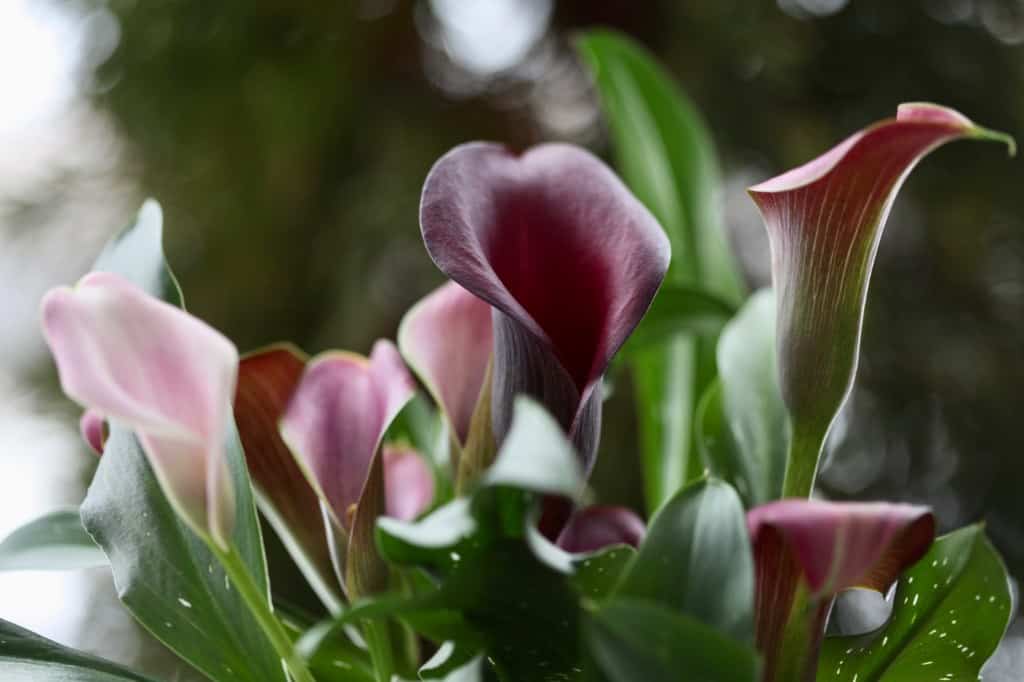
Calla lilies are flowering plants that can last for many years if given the right care, returning to bloom each year with renewed vigor.
This beautiful plant produces very simple and unique flowers, which are fabulous cut flowers and long lasting in the vase.
Are Calla Lilies Perennials?
Calla lilies, also known as zantedeschia aethiopica by botanical name, are rhizomatous herbaceous perennials.
These plants grow from rhizomes, which are often referred to as bulbs. Although the rhizome structures from which the callas grow sometimes resemble bulbs, they are not true bulbs.
They are in fact rhizomes.
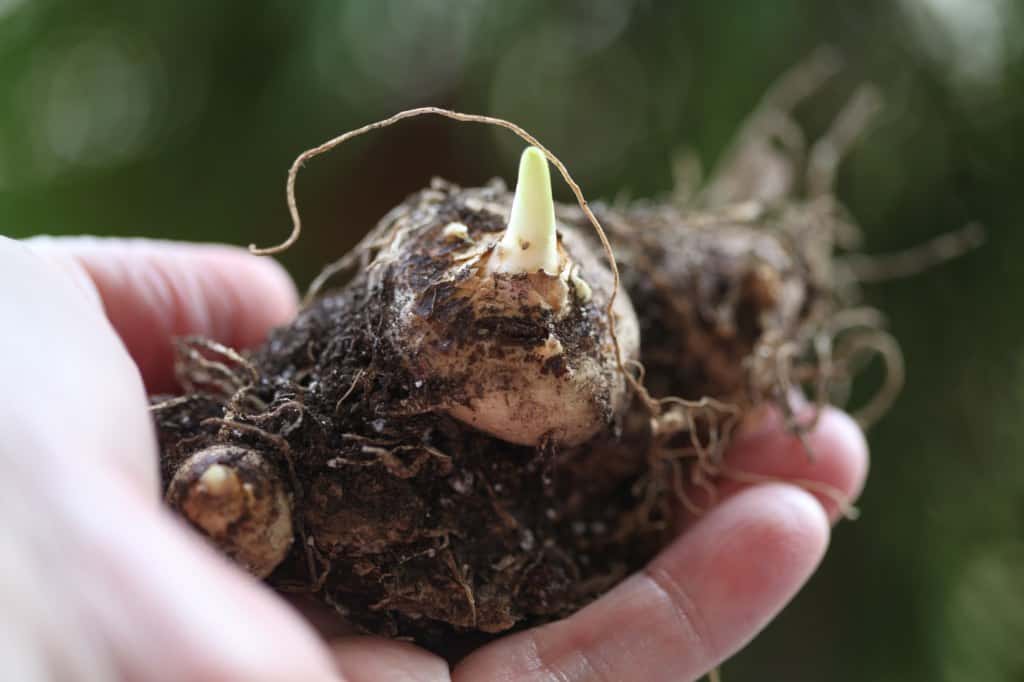
These plants are perennials in warm climates, such as in usda hardiness zones 8 and up. In these growing zones, the calla lilies can be left in the ground to over winter.
They can be left in the ground to naturalize and spread.
If they are happy with their growing space, they will come back year after year.
Since Calla lilies are perennials in warmer growing zones, you would think that they would only be able to be grown in these areas.
Fortunately for the gardeners in cooler climates, this is not the case.
We can actually grow calla lilies in most growing zones.
In cooler areas and growing zones, the rhizomes will not survive the winter in the ground. But take heart, the plants can still be grown.
They just can't be left in the ground to over winter where the ground freezes. In colder zones they will need to be dug up and stored.
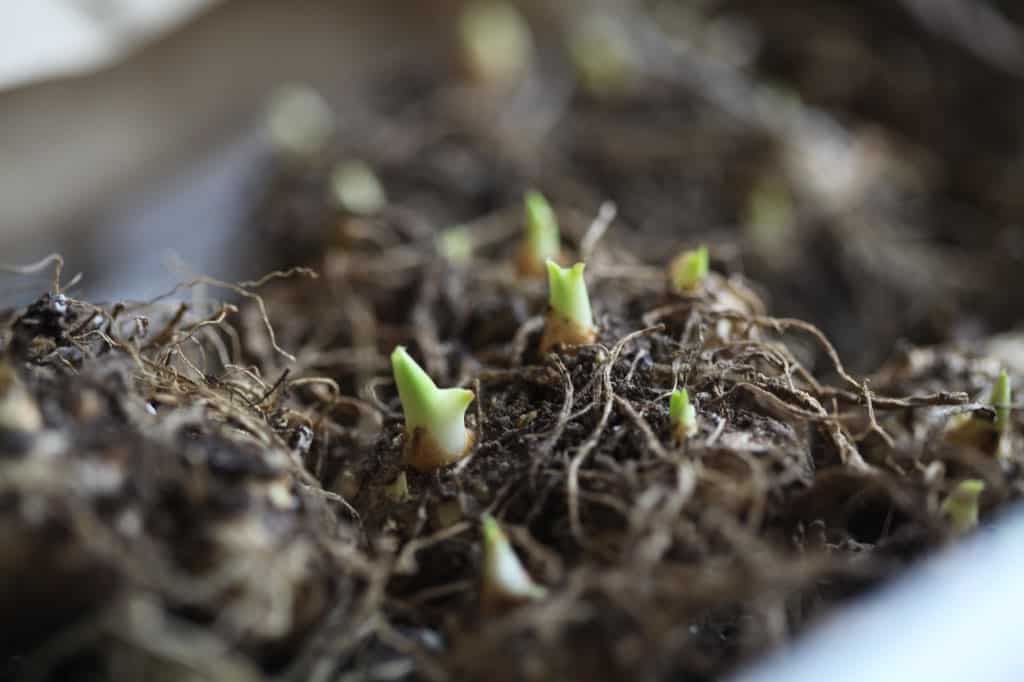
Where Are Calla Lilies Grown?
In colder areas z. aethiopica are easily dug up at the end of the season. This helps to preserve them, and to keep them from freezing overwinter.
The rhizomes are brought inside where they will not freeze. They can then can be planted back outside the next season once the risk of frost has passed.
Calla Lilies Can Be Grown Indoors
Calla lilies make great container plants.
They are often grown in pots or containers, and sold in big box stores for growing inside the home as an indoor plant. You may notice the availability of these plants during the late winter.
They are fabulous potted plants, easily adapted to the indoor space.
When Calla lilies are grown inside in pots, they can be grown in any growing zone.
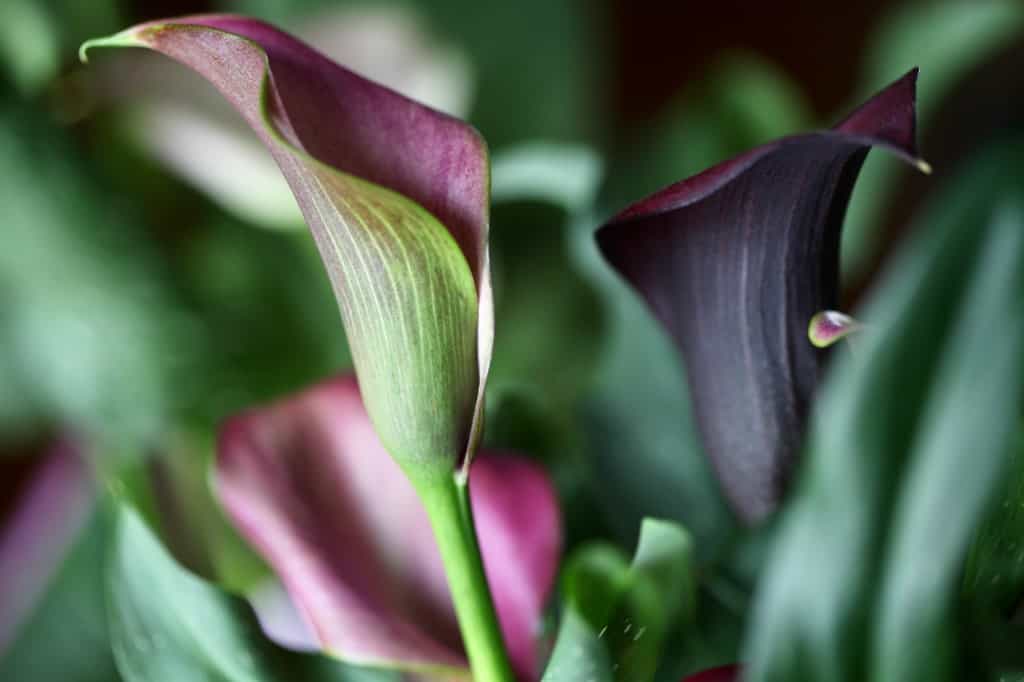
Calla Lilies Can Be Grown Outdoors
Calla lily plants are also grown outside in the garden during the warm summer months. They can be successfully grown in any growing zone outdoors.
As long as they are not left outside to over winter in colder climates, the plants can be long lasting for any gardener.
When grown outdoors, calla lilies can be planted in pots, as well as directly into the garden.
Calla lilies are known to grow very well in pots.
They grow so well in fact, that some gardeners keep them in pots even when planting them into a garden bed. The calla lilies can be placed into the garden bed, pot and all.
The key to growing these plants outdoors in colder zones is to plant them out in spring, and then dig up the calla lily bulbs or rhizomes in the early fall.
Dig them up before exposure to cold and frost in the fall. Store in a dry place until early spring.
Calla lily plants are very easy to store and plant with minimal effort for longevity of the rhizomes.
Next spring they can be planted out again to produce new calla lily blooms for yet another season. You can also try your hand at collecting the seed, and try growing calla lilies from seed if you are so inclined.
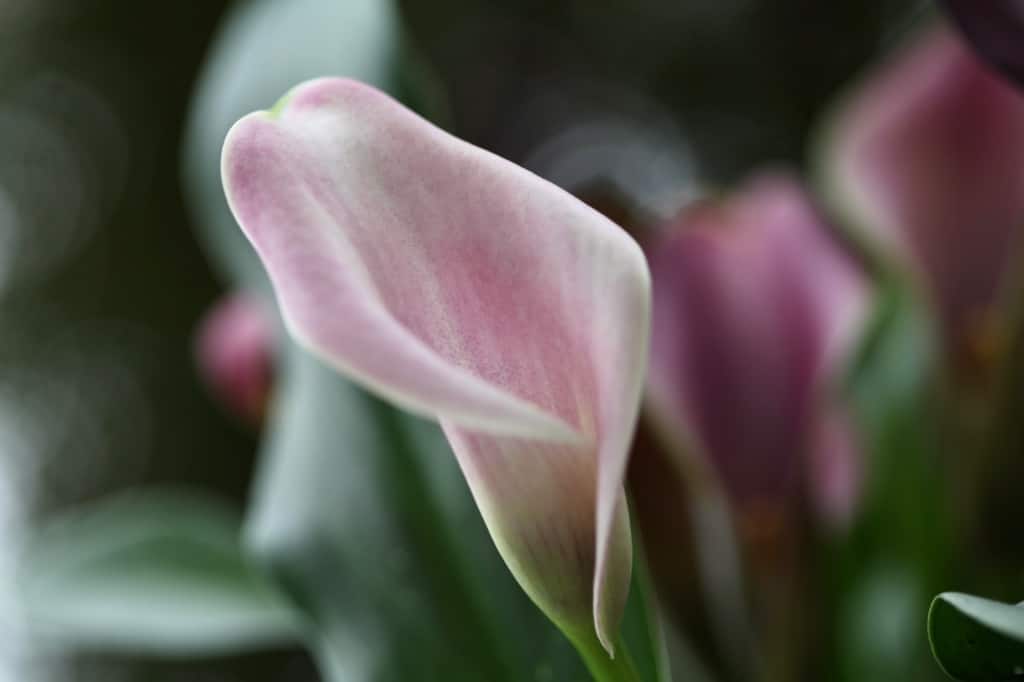
What To Do With Calla Lilies After They Bloom
No matter where they are grown, either indoors or out, calla lilies will have their bloom time. Then following this period, they will slowly recede into a dormant state.
This dormant state is a rest period, and important in the life cycle of callas for blooming the following year.
During the time between the end of blooming and dormancy however, and especially immediately after blooming, the leaves can remain lush for quite some time.
It is important therefore to continue to care for callas after blooming. This is important so that they can continue to store energy for next year's blooms.
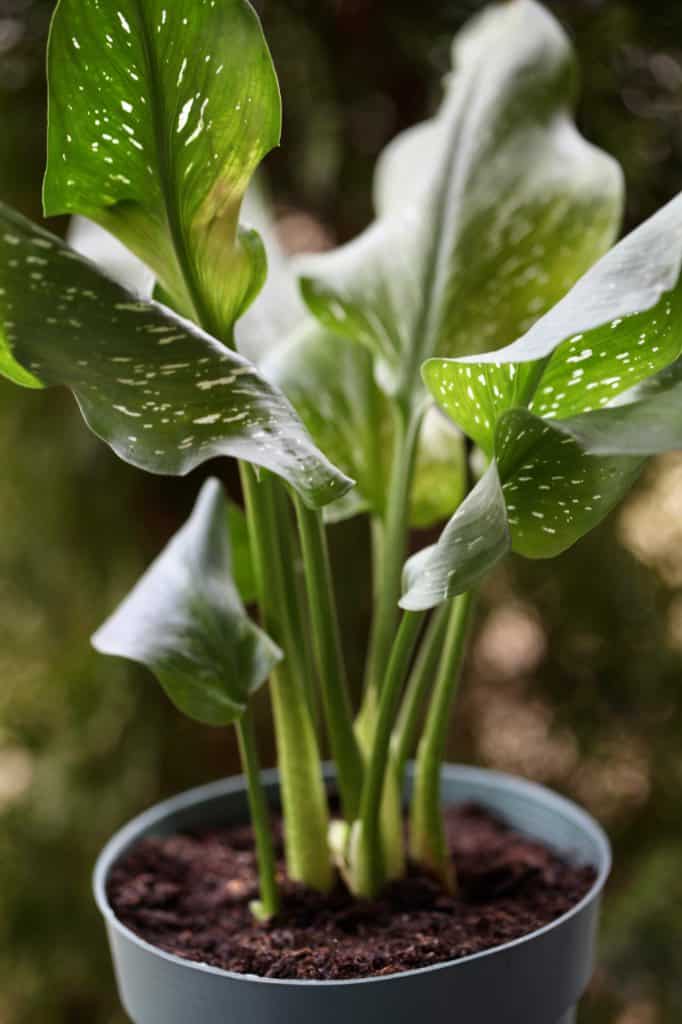
Whether growing in the garden or in a pot indoors, calla lilies can be enjoyed as a houseplant or garden plant with fabulous green leaves after they have finished blooming.
Continue to care for the calla lilies until these leaves start to recede.
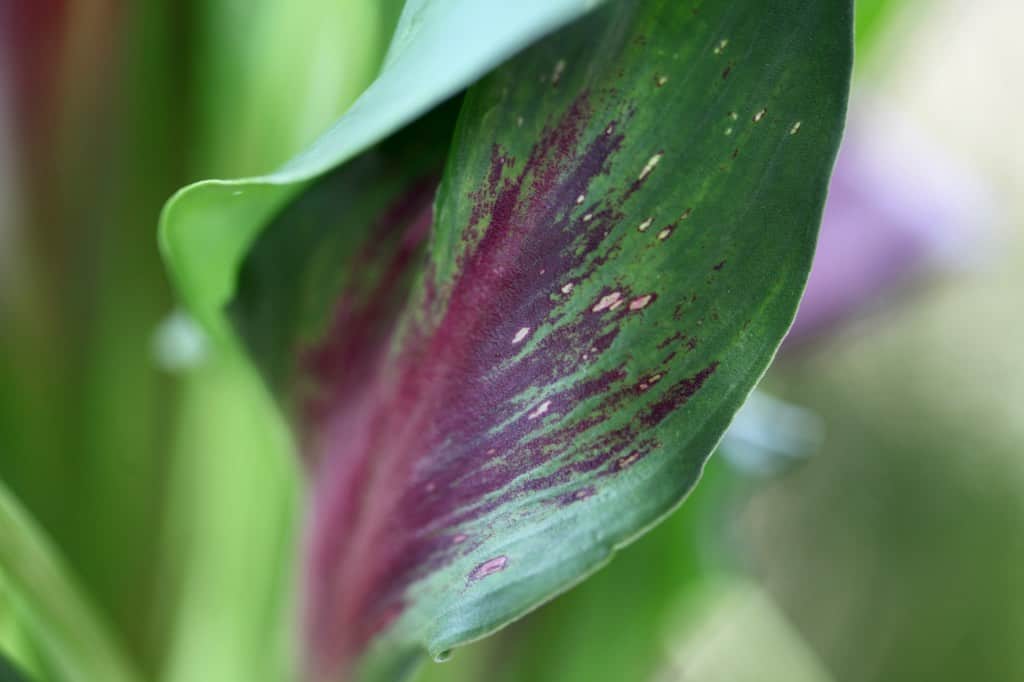
When the leaves start to turn yellow and recede, remember that this is just part of a natural process. The rhizomes are going dormant, and this important period must occur in order for the calla lilies to bloom again.
What exactly do you do for calla lilies after they have finished blooming, and before the dormancy period?
Let's take a look.
Calla Lily Care After Blooming
The timing for calla lily care "after blooming" can actually begin during the blooming period, and involves care provided to the plant after each individual bloom has finished blooming.
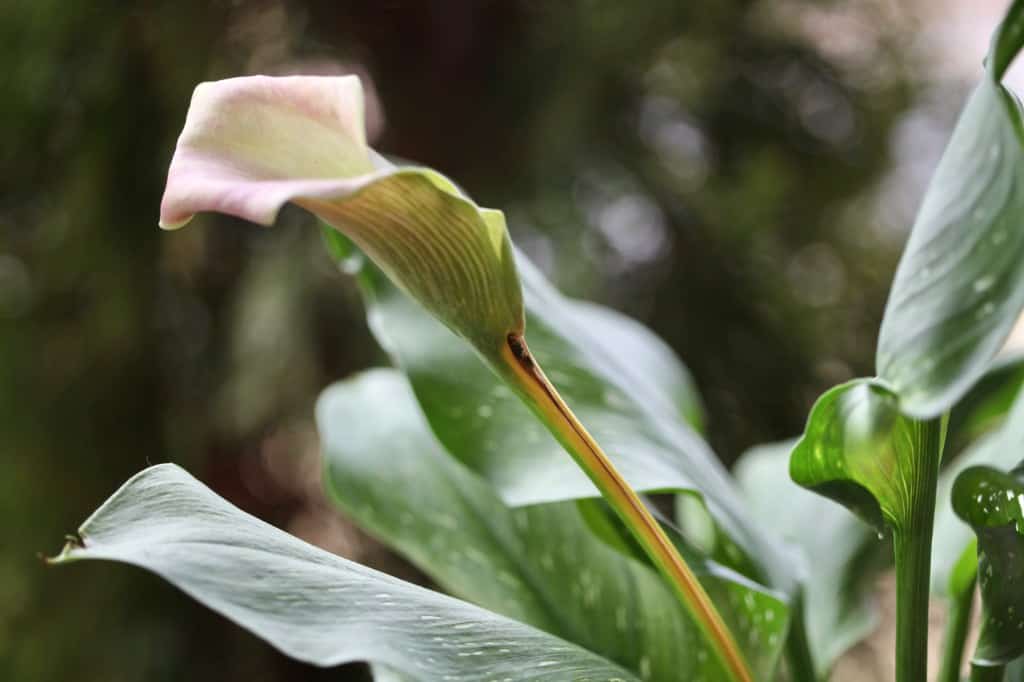
Calla lilies can bloom for a flowering period of approximately six to eight weeks depending on the size of the plant, and the energy which has previously been stored in the rhizome.
Each individual flower stem will bloom for about two weeks, and the plant itself will continue to produce flowers throughout the blooming period of six to eight weeks. Individual flowers can be in different stages of growth throughout this period.
Some flowers therefore will have finished blooming, while others are still growing.
So let's have a look at how to manage the plant after blooming, including what to do with the spent flowers during the blooming process.
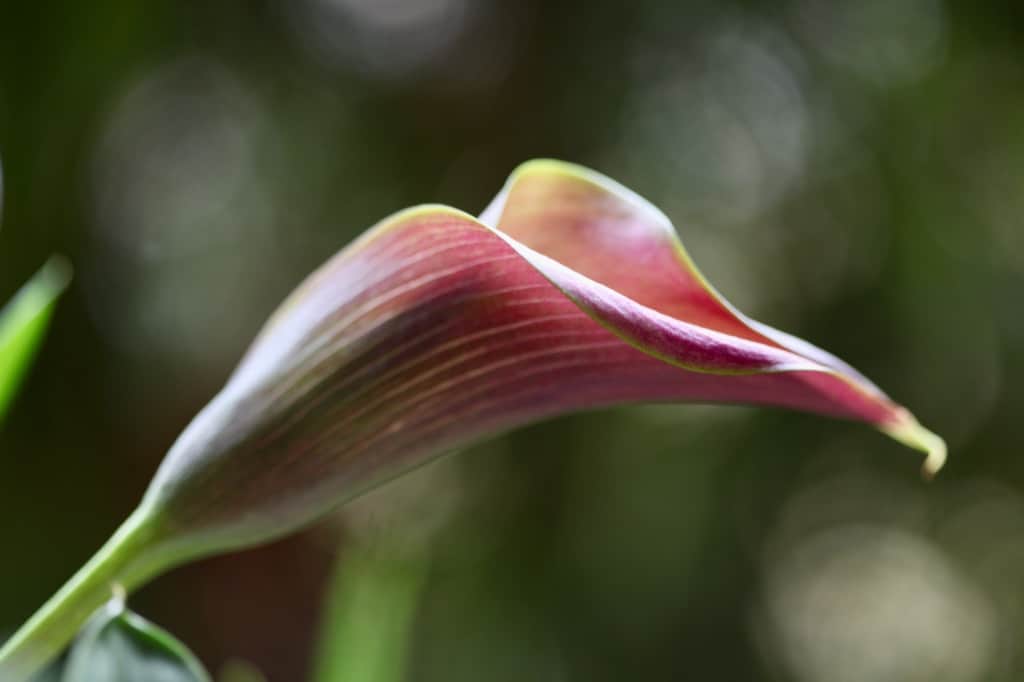
What To Do With Indoor Calla Lilies After They Bloom
For calla lilies planted indoors in pots, you are more likely to attend to these plants on an ongoing basis than those that are growing outside.
They are likely on display for all to see, and it's very easy to stay on top of the care.
As calla lilies are blooming, you will find that the plant has blooms in various stages. Some flower stems are in full bloom, while others are just starting to grow.
As each flower has finished blooming, it's a good idea to clean up the plant to conserve energy for the plant's growing cycle.
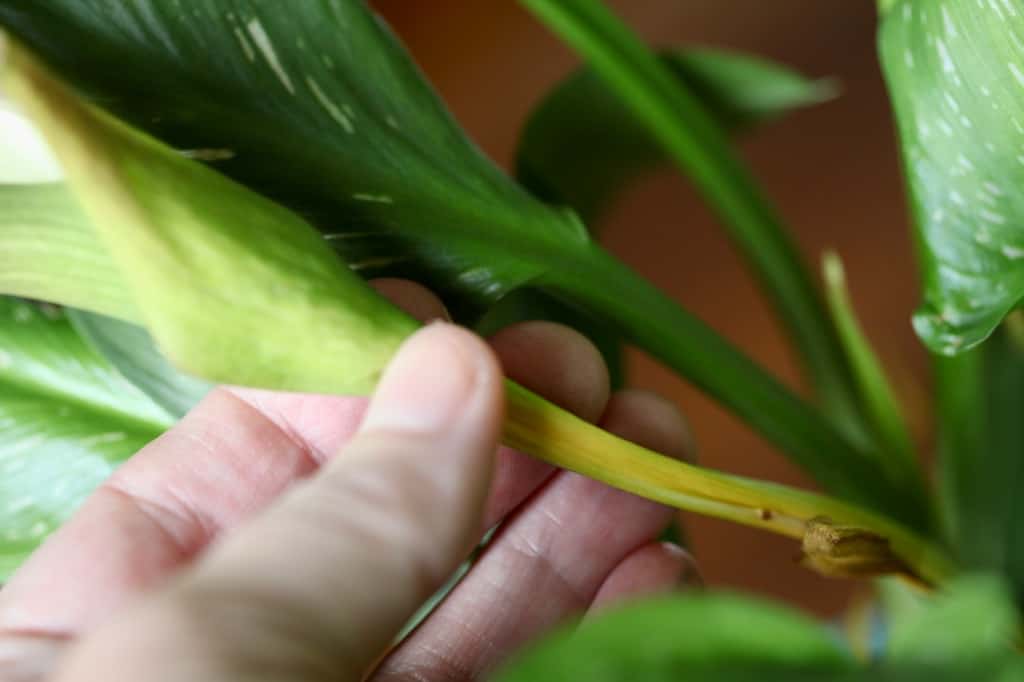
Remove Spent Blooms
Remove the spent blooms individually, when they become spent.
As the first potted calla lily blooms start to fade, and the stems turn yellow or the flowers begin to discolour, it is a good idea to remove these blooms. Reach deep down into the plant and cut the spent stem at soil level.
Remove only the spent blooms and faded leaves on the calla lilies that have finished flowering.
This will preserve the plant's energy for the remaining blooms, as well as clean up the plant for a tidier appearance.
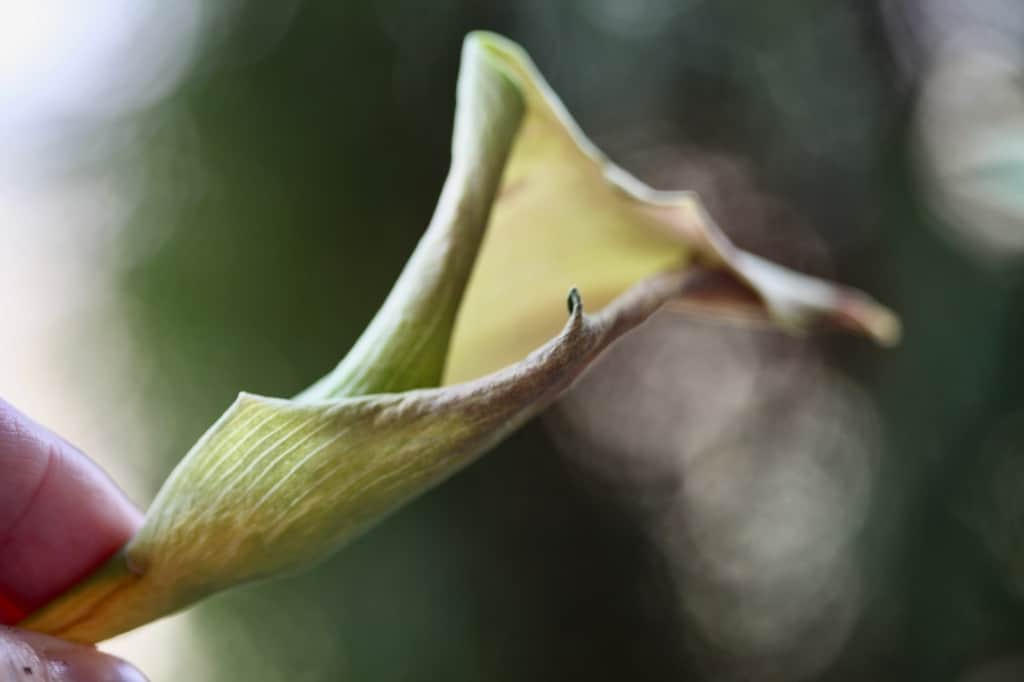
Removal of spent blooms is essentially deadheading the calla lilies.
I tend to do this on a regular basis throughout the blooming period for calla lilies growing in pots indoors, rather than waiting for all the flowers to bloom and then deadheading the plant after blooming.
Deadheading as each flower becomes spent keeps the plant fresh in appearance and preserves the plant's energy.
I also deadhead spent blooms for callas growing in pots outside, although perhaps less meticulously than those grown indoors.
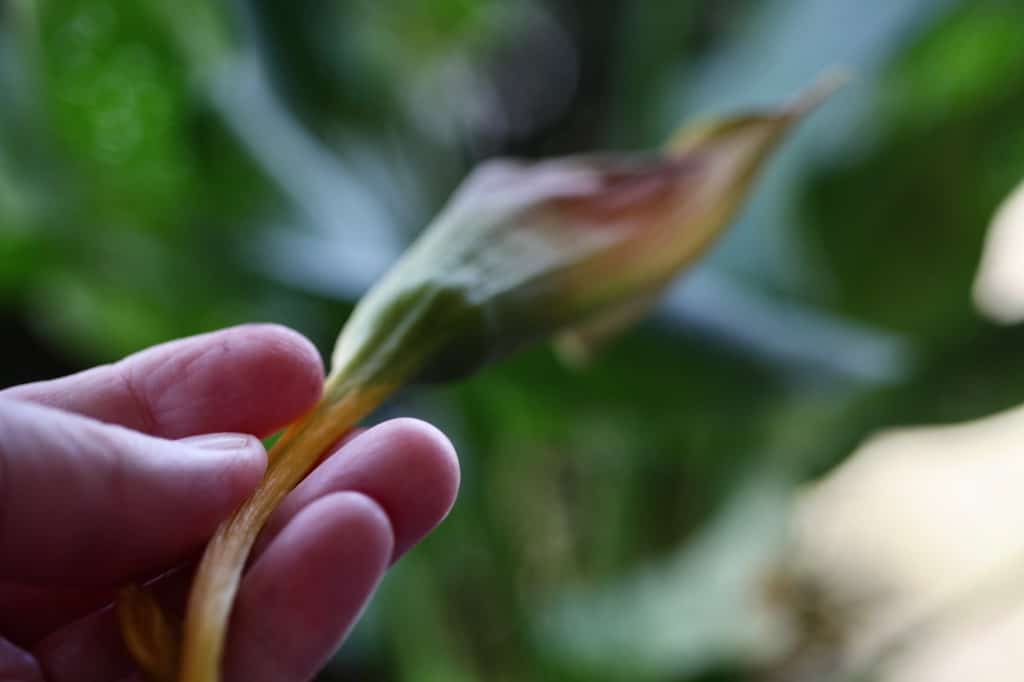
Remove Spent Foliage
Prune back the foliage as well as it begins to turn yellow.
You will notice that sometimes just one or two leaves may turn yellow and fade, and the others remain green.
This process does not occur all at once, so I tend to just prune out individual leaves as they are turning yellow, leaving the green leaves intact.
After the flowers have finished blooming, the green leaves can remain for quite some time before they start to fade away.
Allow the leaves to continue to grow.
Continue to water and care for the plant as you would during blooming. The leaves are providing energy and nutrients to the rhizome for future blooming.
The leaves are feeding the rhizomes through the process of photosynthesis..
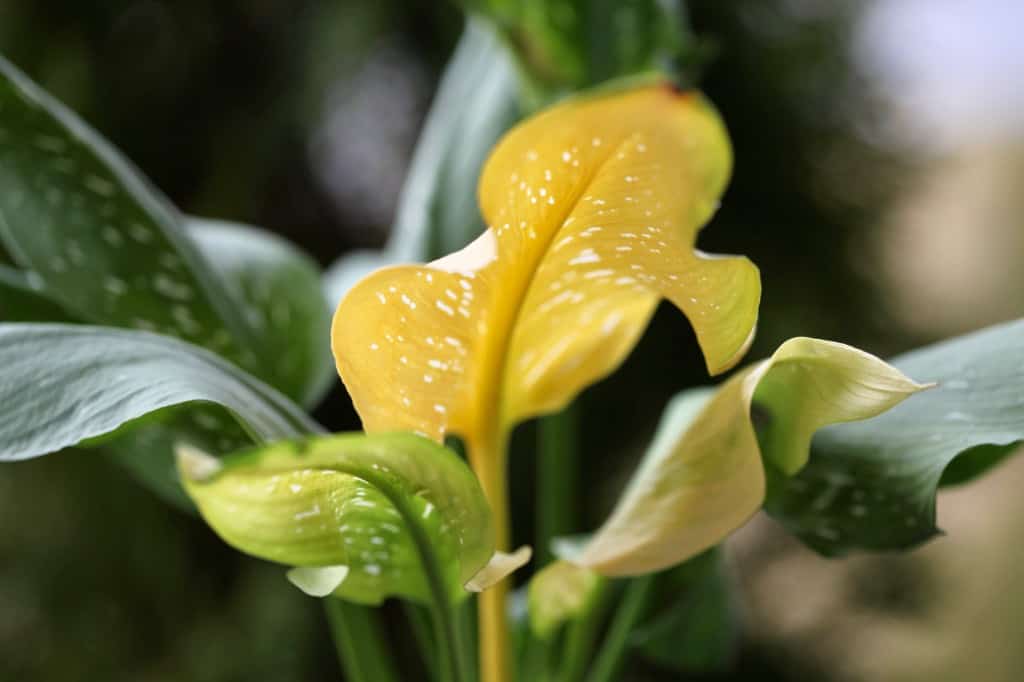
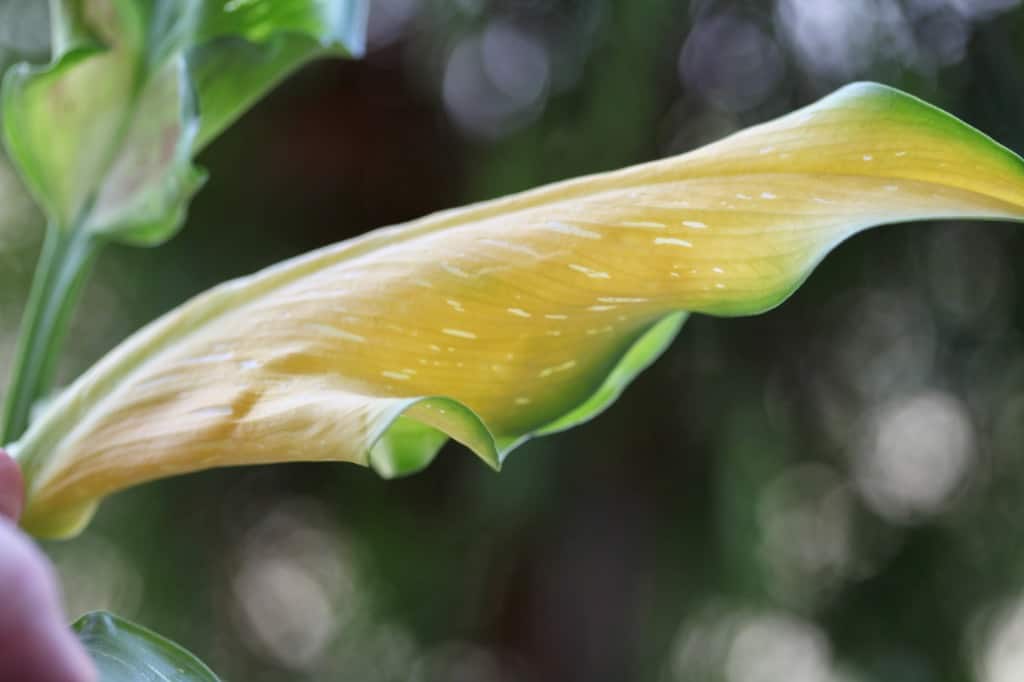
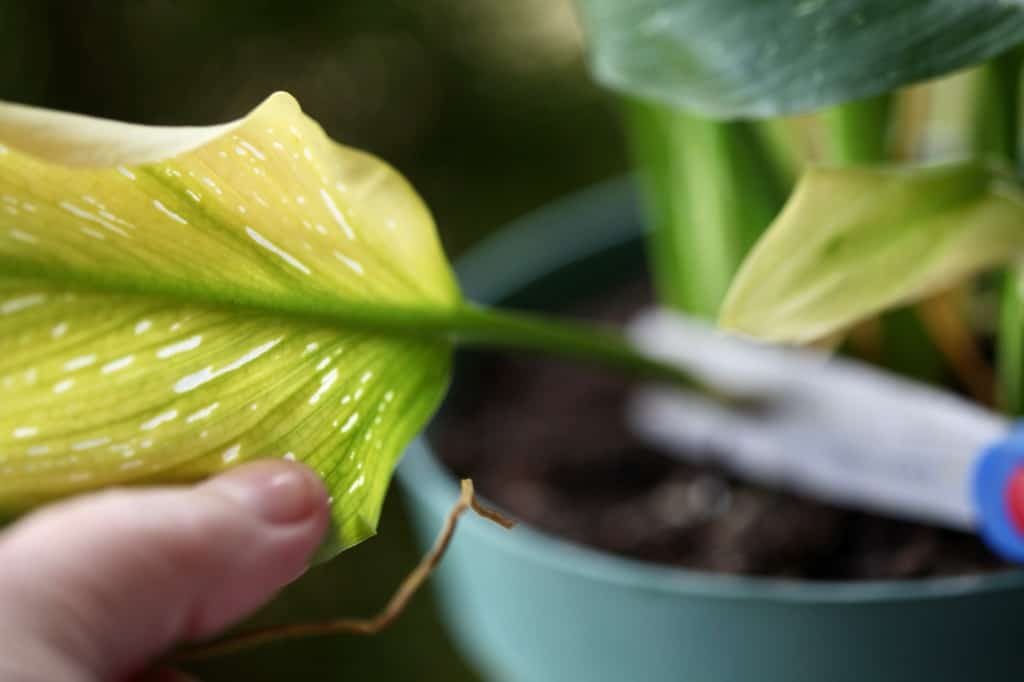
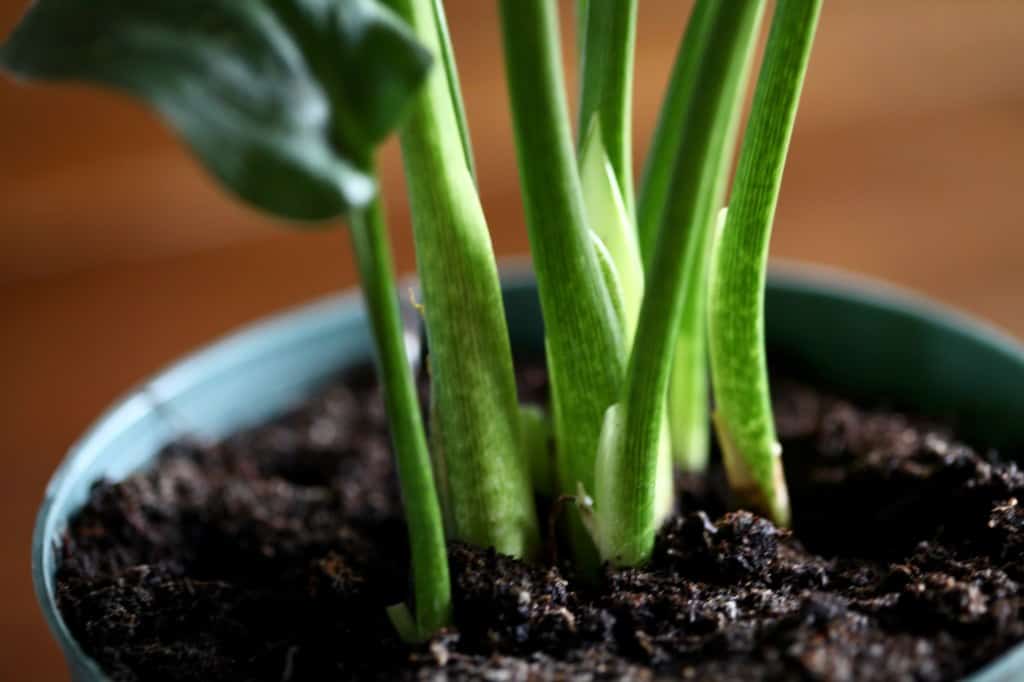
Watering After Blooming
Water calla lilies a bit less than you would in the active phase of blooming, which is generally around twice a week during bloom time.
Calla lilies normally like a moist soil, but not a water logged soil, which can cause root rot.
After the plant has finished blooming, yet green leaves remain, let the moisture on the top of the soil guide your watering schedule. Provide enough water for continued growth of the leaves.
Continue to water the plant which can continue to grow for some time before going into a dormant state.
The soil should remain slightly moist to the touch, and not dry out completely at this time.
The green leaves can be very attractive, and can be cared for as a houseplant if grown in a pot indoors.
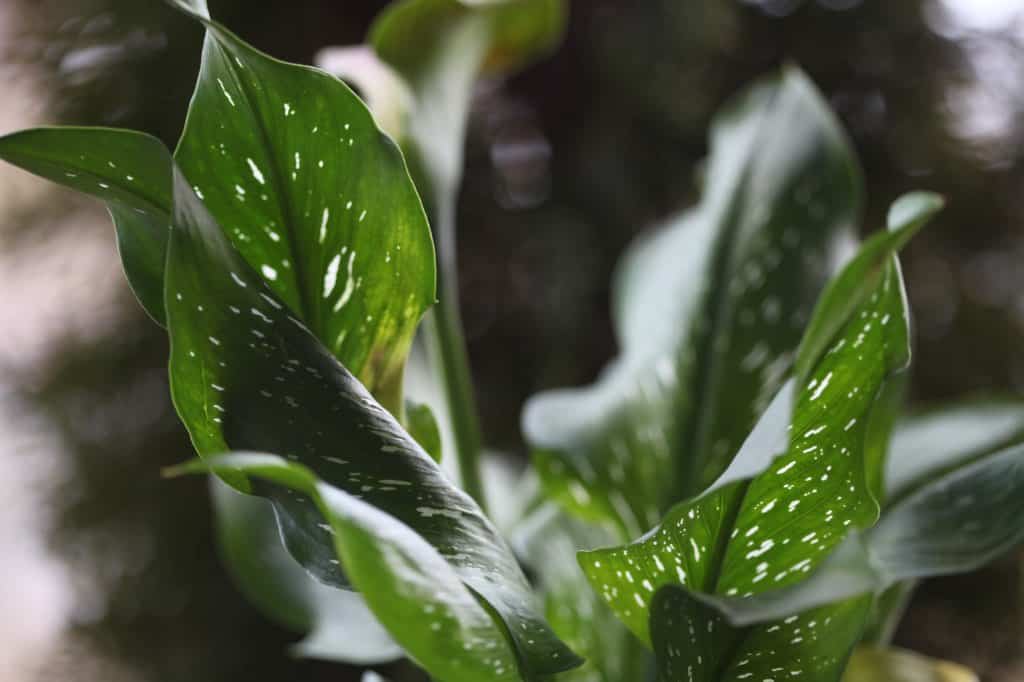
Once the leaves start to fade however, it is evident that the plant is becoming dormant.
At this point you can gradually reduce watering, as the plant is becoming dormant.
When dormant, you can stop watering.
It's now time to allow for the dormant period, with proper storage of the rhizomes until the next blooming cycle.
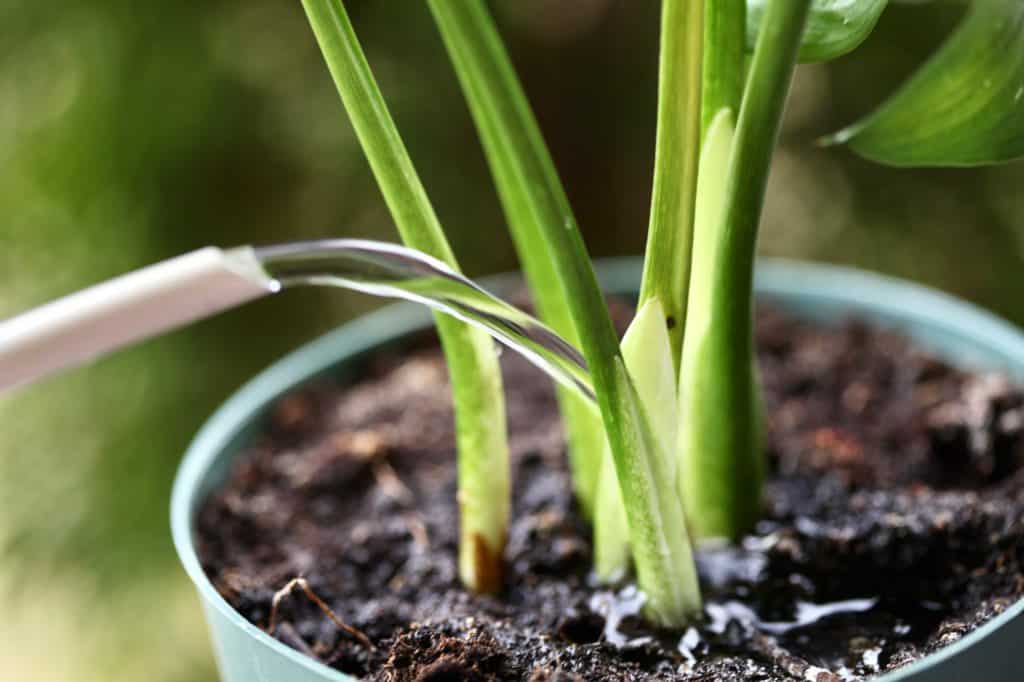
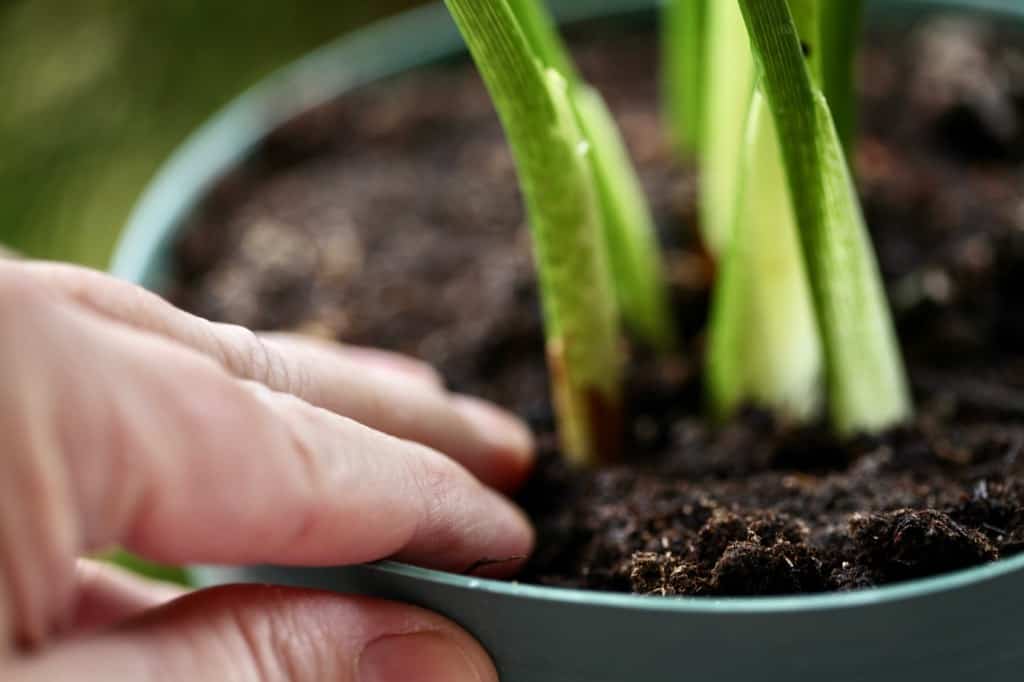
Calla Lily Care After Blooming Outdoors
Care of calla lilies growing outside in pots or in the garden is the same for those that are grown indoors. It may be however, that you are not on top of each and every spent bloom in the garden, and that is okay.
If grown in a pot outdoors, or growing in a garden bed, just continue to care for the plant as you would any other plants in the garden.
When grown outdoors, what you will find is that the leaves will begin to turn yellow and fade in late summer or early fall, as the temperatures become cooler.
For best results, allow the leaves to die back naturally, rather than pruning them.
I only pull off the leaves after they have died back completely. I will also cut the leaves just before I dig up the rhizomes to bring inside, to remove them from risk of freezing temperatures in the outdoor environment.
At the end of the growing season, some gardeners will wait until after the first frost to dig up their calla lilies, to bring the rhizomes inside.
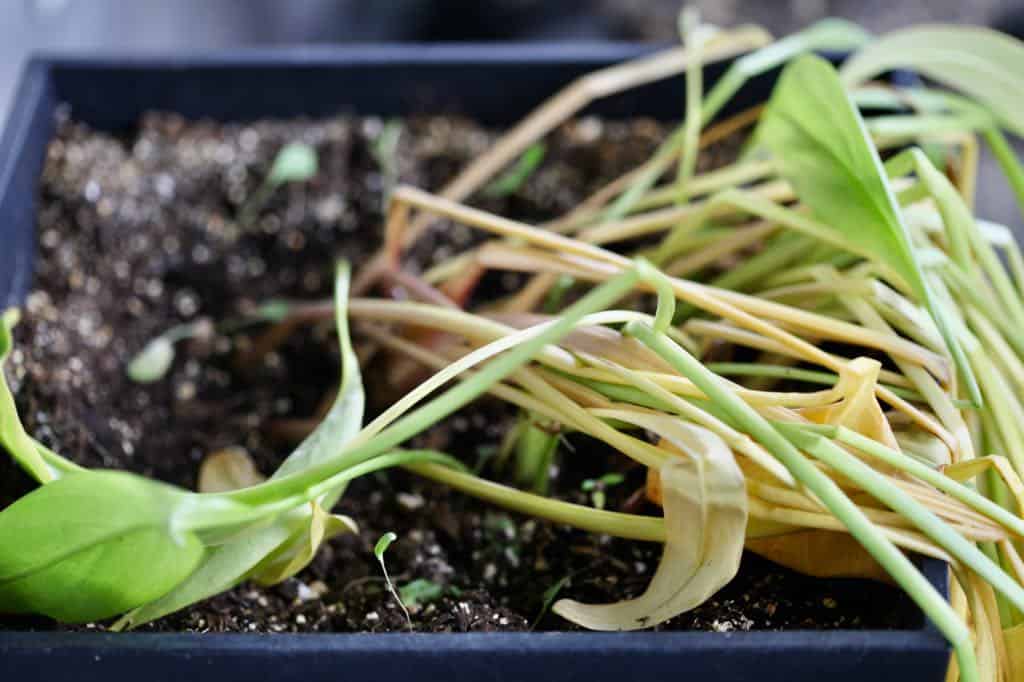
Storing Calla Lilies Over Winter
Now let's have a look at the storage process for calla lilies.
Storing Calla Lily Rhizomes From The Garden
If you grow calla lilies in usda growing zones 7 and colder, you will need to dig up and store your dormant calla lily rhizomes if they are planted outside in pots or in the garden.
As discussed, prior to digging the leaves will have yellowed and faded. This is a sign that the plant has gone into the dormant state.
Sometimes the leaves will also turn brown and crispy. They may have fallen away from the plant so that there is nothing left above the soil level.
If there are leaves remaining however, just cut them right back to about an inch above soil level, prior to digging.
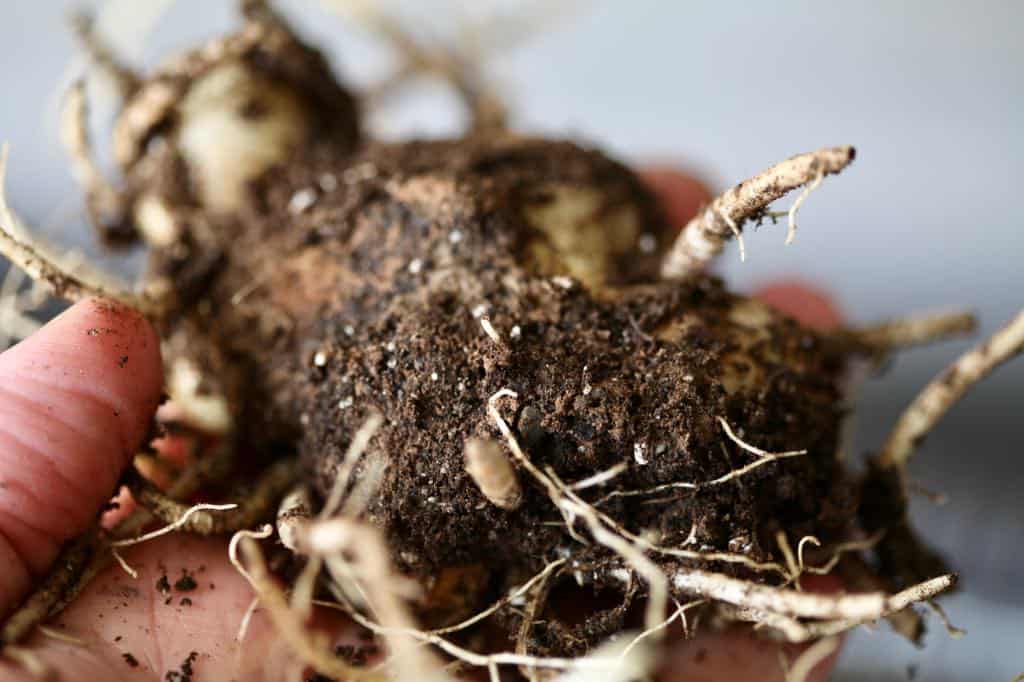
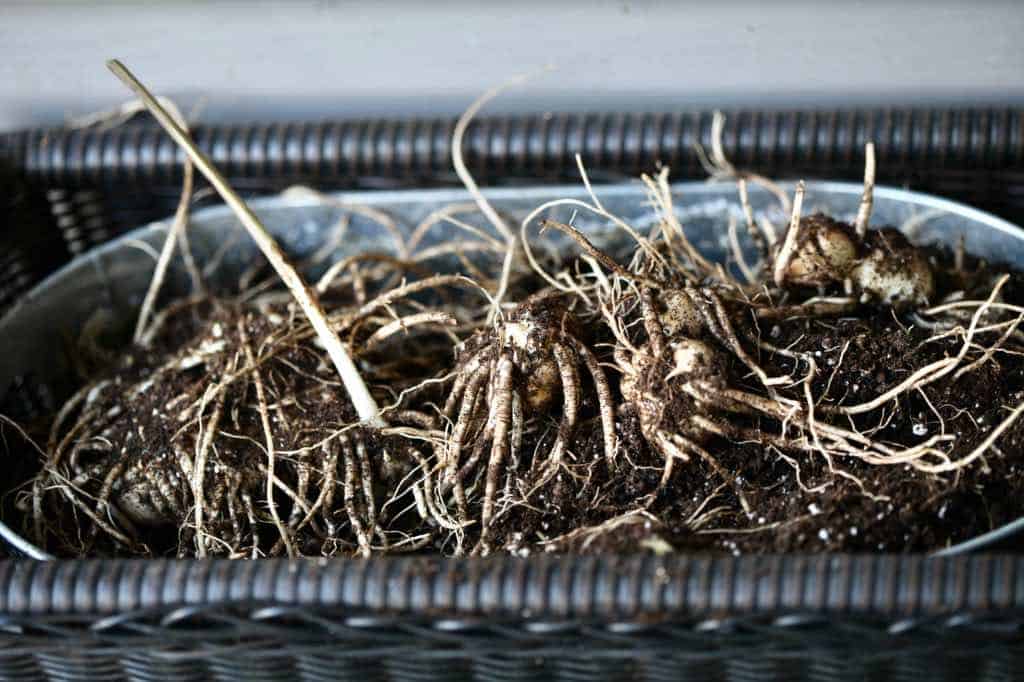
Dig around the plant with a shovel, revealing the rhizome parts with roots attached.
Shake off the soil, and place the dug rhizomes into a container in a single layer. This allows for good air flow and helps them to dry.
Dry for several days or longer. A cardboard box with holes makes an excellent absorbent container.
You can then further protect the rhizomes by then wrapping them individually in newspaper after they are completely dry. This will help to keep them dry and insulated until they are ready to plant out again in spring.
The most important thing is to keep the rhizomes dry.
Store in a cool and dark place, until ready to plant out the next growing season.
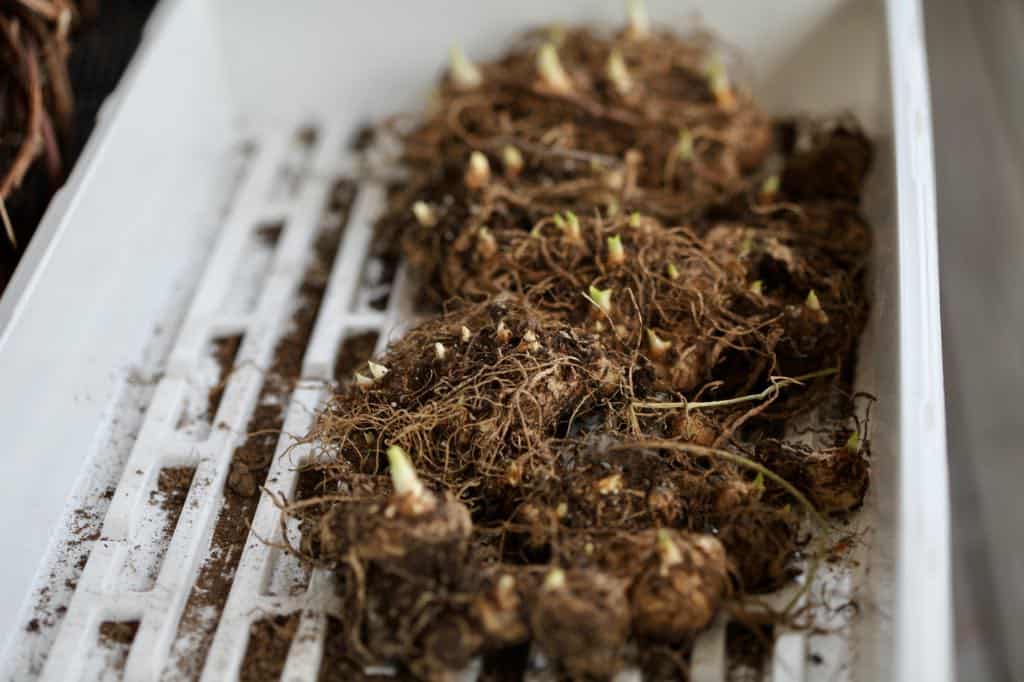
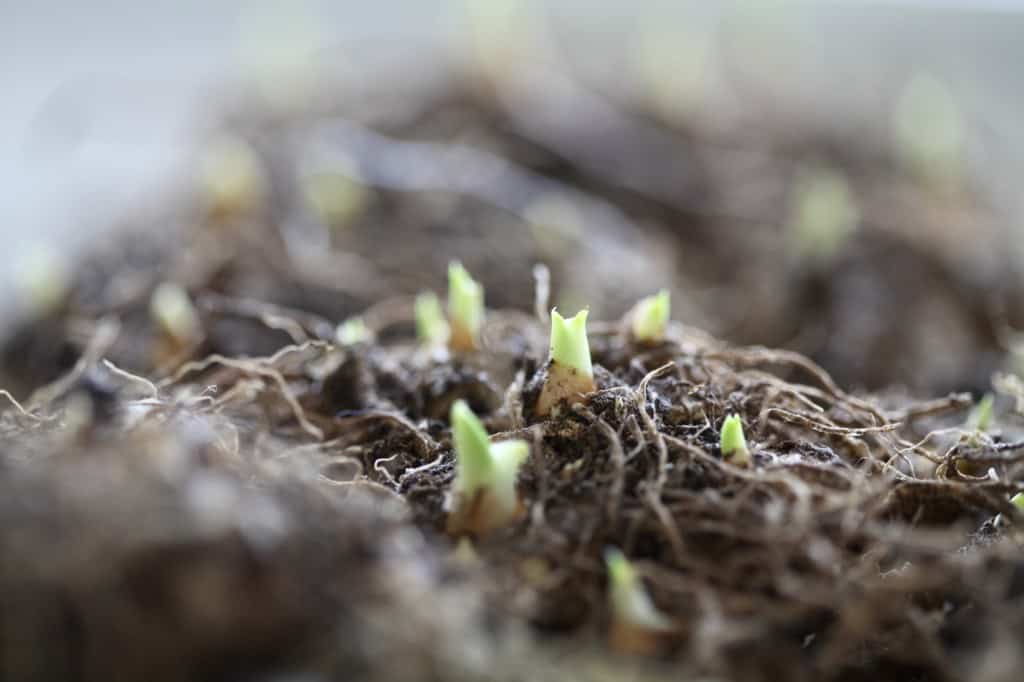
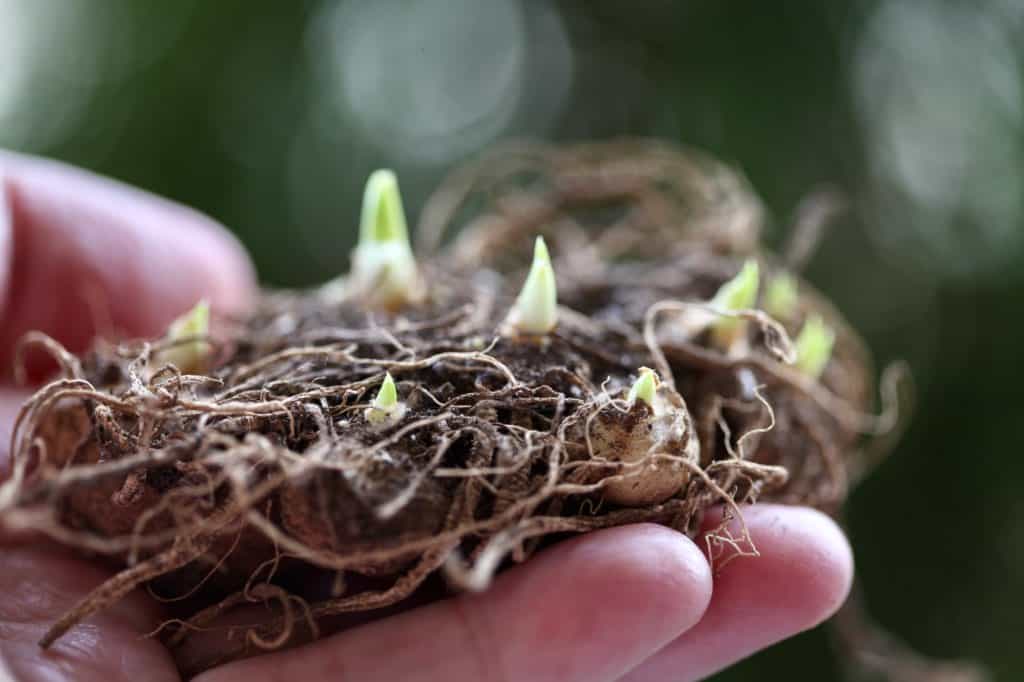
Storing Calla Lily Rhizomes From Pots Indoors
If the plants have been grown in pots inside, you will know when the rhizomes have become dormant. At this point you will have hopefully stopped watering the pot.
The soil in the pot with the dormant rhizome will be dry.
To store, you can do exactly the same thing with these rhizomes grown indoors as those brought in from outside.
You can take them out of the soil, allow them to dry, and then wrap in paper for further storage.
Alternately, you can just keep them in the pot of dry soil, and store them away in this manner.
Store the wrapped or potted rhizomes in a cool and dark area until ready to be planted the following spring.
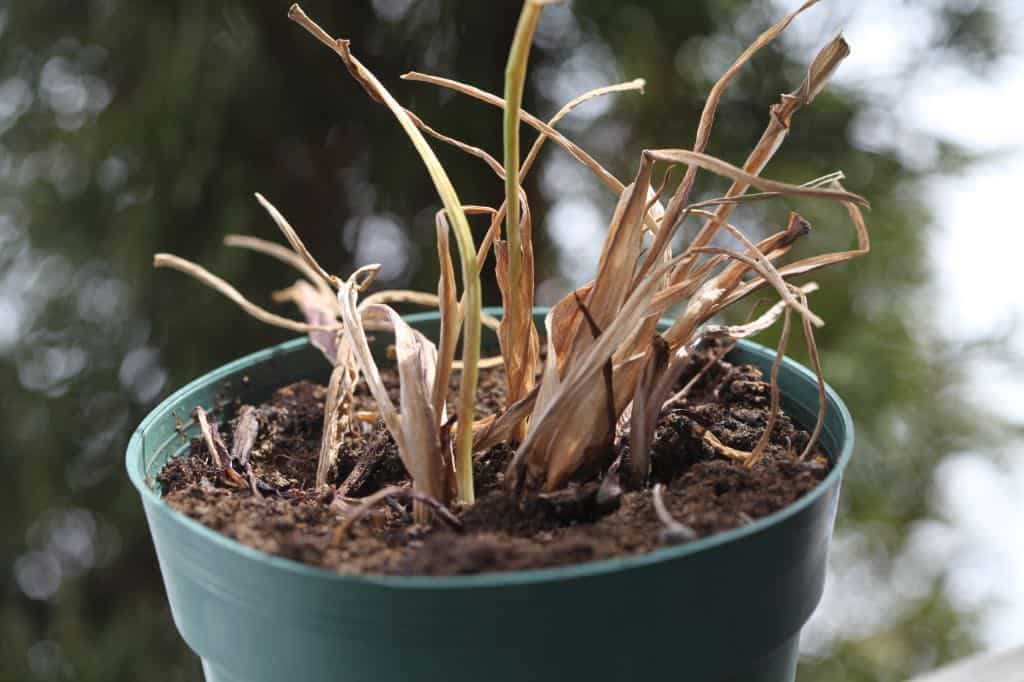
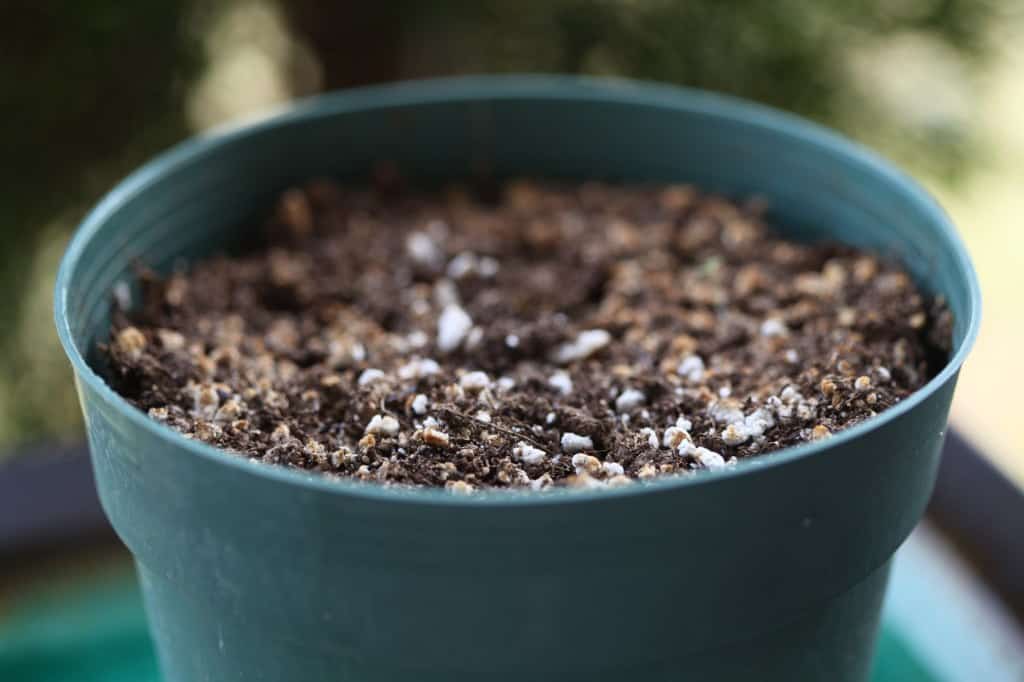
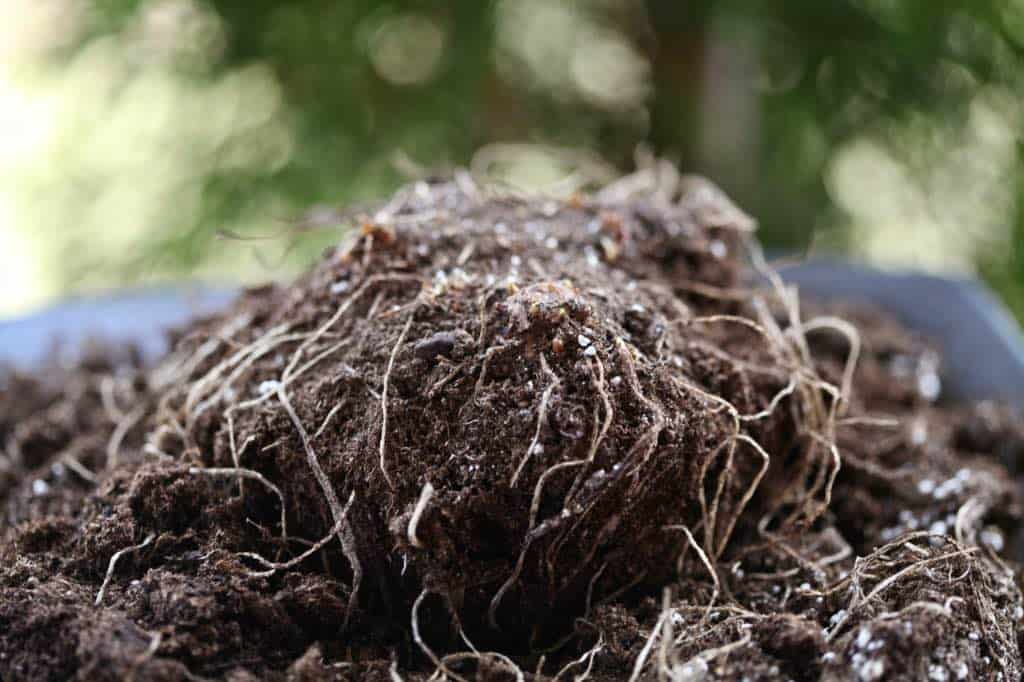
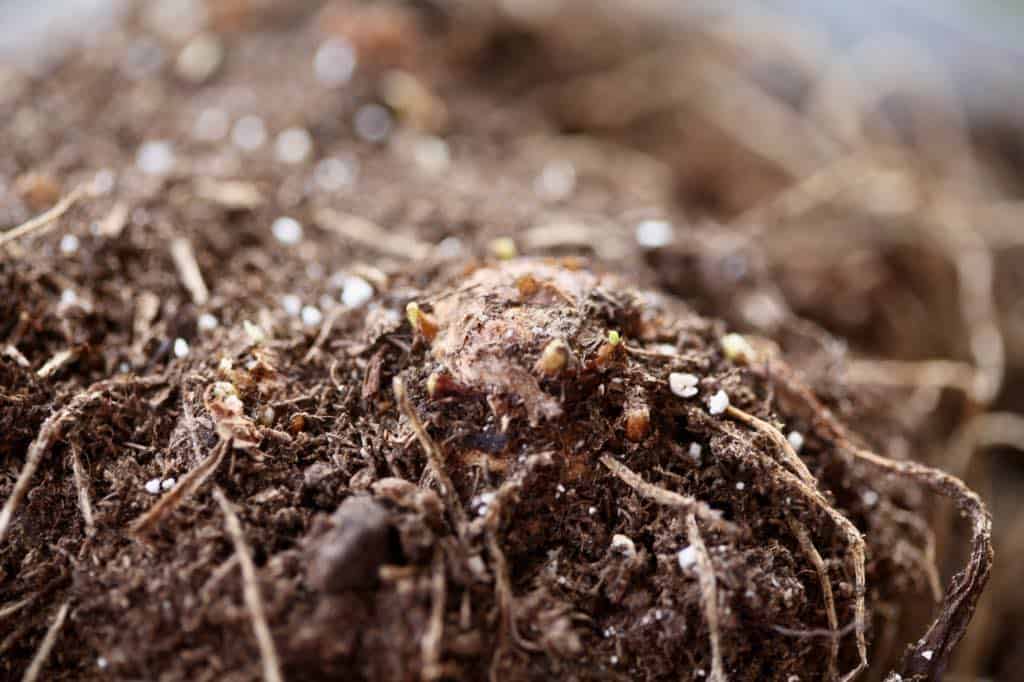
Do Calla Lilies Need To Be Cut Back In The Fall?
If you are growing calla lilies in the garden, and you are in zone 8 and above, you will be able to leave the rhizomes in the garden to overwinter.
There is no need to cut the calla lilies back in fall. The foliage will naturally compost into the ground as will occur with the other plants in the garden.
If you are in zone 7 and below, it is important to dig up the rhizomes for winter storage. They will not survive a winter freeze if left in the ground.
In this case, as part of the digging process, it's a good idea to cut back the foliage. It's important to have as little foliage attached to the rhizome as possible for storage.
Eventually the foliage will dry and fall away from the rhizome itself.
From my experience, after the foliage has died back naturally, it just easily pulls away from the rhizome on it's own with just a gentle tug for assistance.
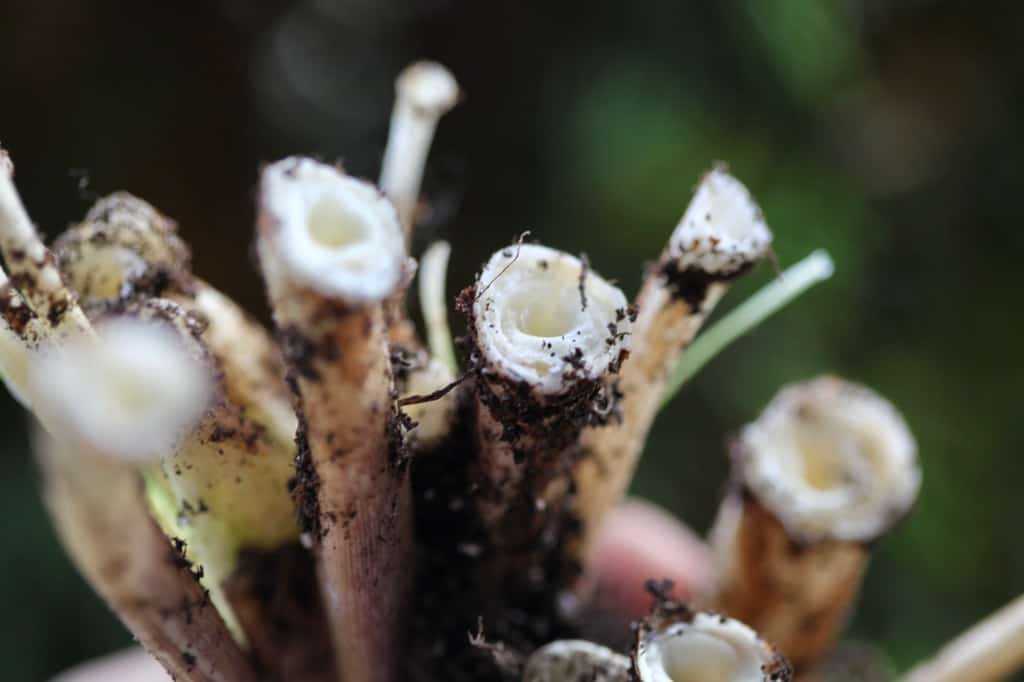
Do Calla Lilies Bloom More Than Once?
Calla lilies are perennials which grow from rhizomes.
They can definitely bloom more than once if they are grown with all the right requirements for energy storage and flower production for the following season.
They can continue to bloom year after year, with the right care.
Some people may not realize this if they have bought potted calla lilies to grow indoors in winter. When after blooming, as the plant turns yellow and withers away, these callas may get tossed.
Some may believe that the plant has died, when in fact it has just gone dormant.
With the right after blooming care, the plant should bloom again and again, year after year.
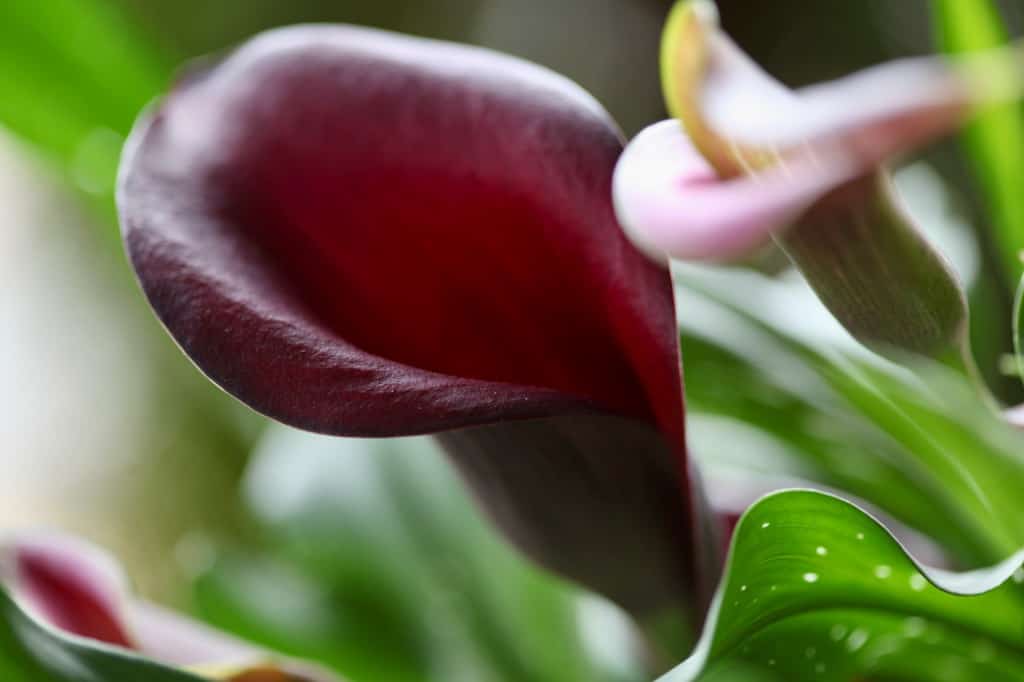
Conclusion
The calla lily flower is simple, and makes a strong statement as a cut flower.
These wonderful flowers look great in a vase.
Calla lilies are unique flowers that are easy to grow and preserve from year to year, no matter what your growing zone.
The right calla lily after blooming care can make a difference for future flower production.
Calla lilies flower for a long time, and can make a great indoor plant, as well as a spectacular outdoor plant. They are also great for gifting.
These beautiful flowers are well worth keeping once the blooms are done, and can be grown on for many years with the right care.
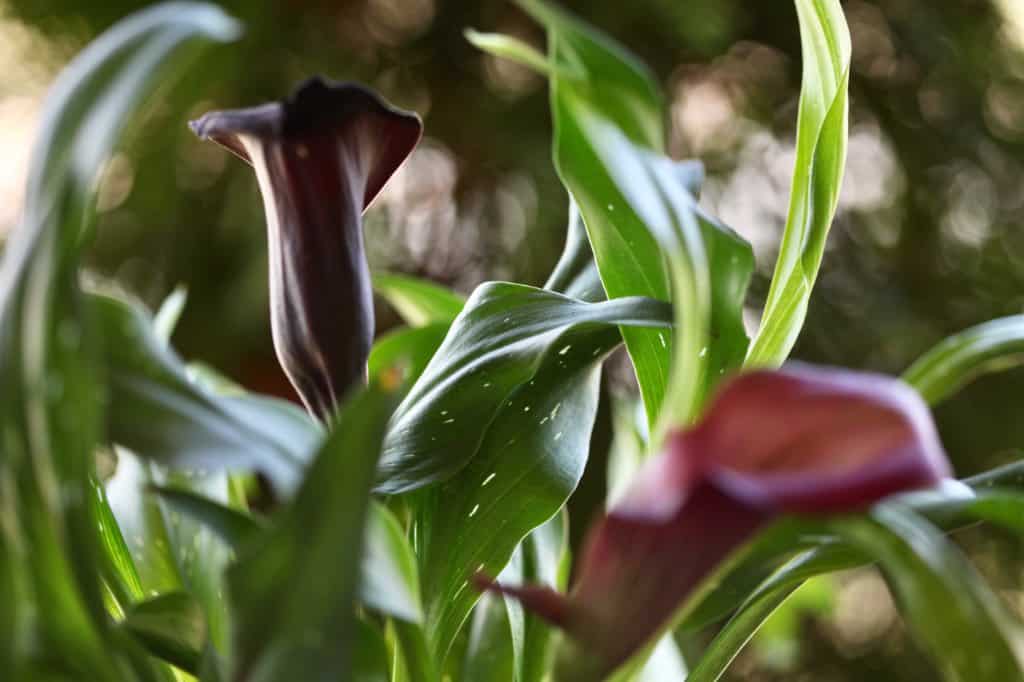
Have you ever grown calla lilies and provided calla lily care after blooming? Be sure to leave a comment below to share your experience.
Other Posts You May Like:
PIN IT FOR LATER!
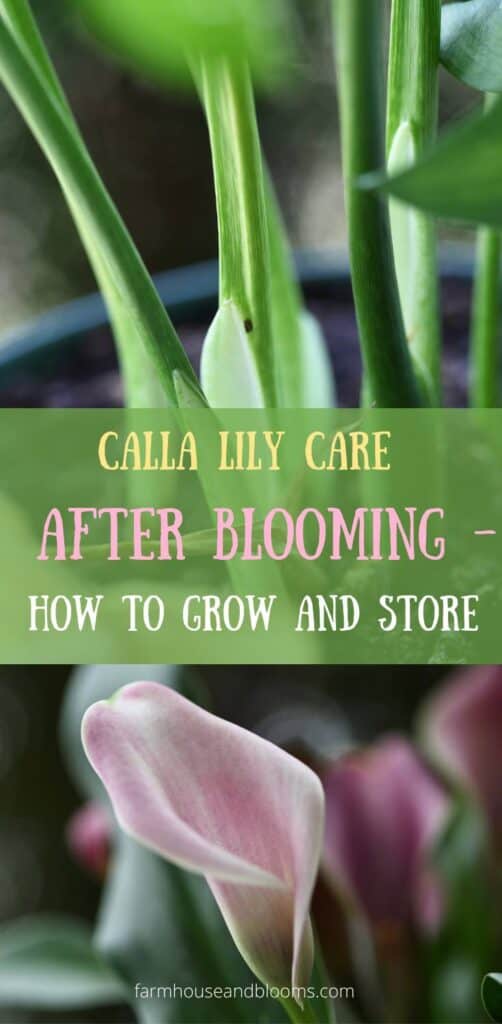


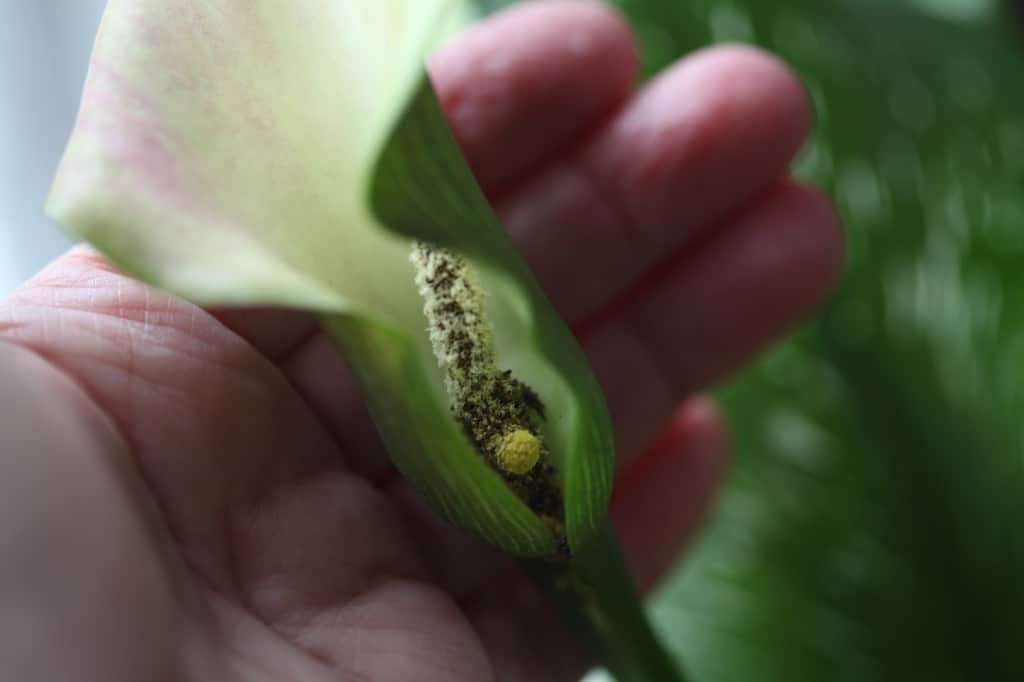
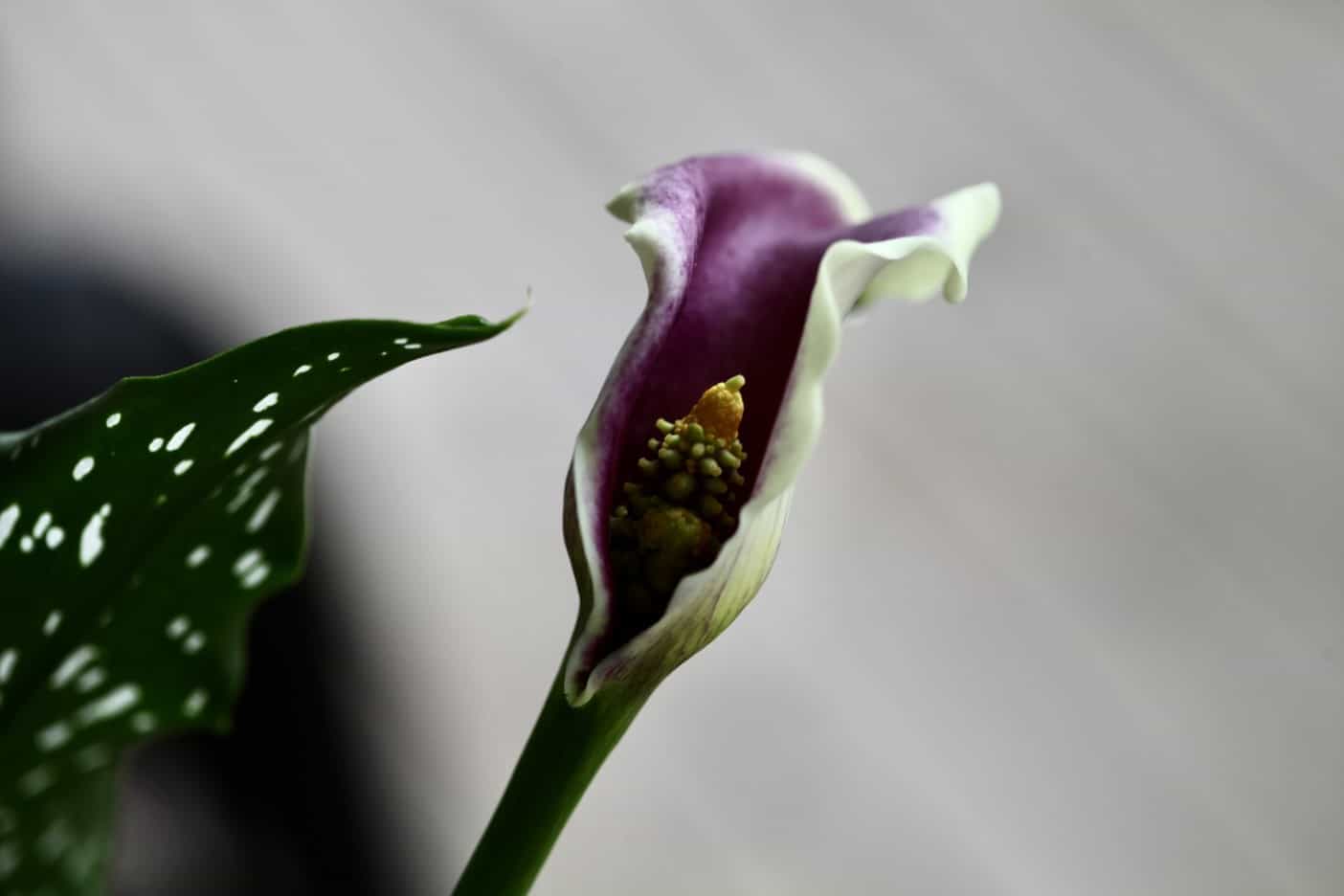
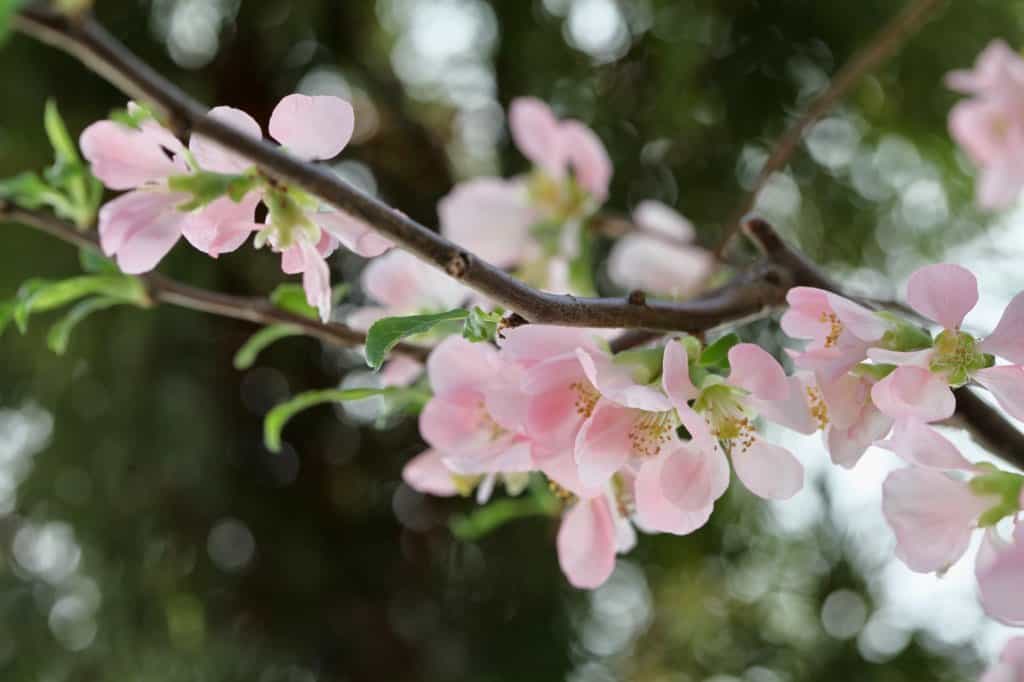
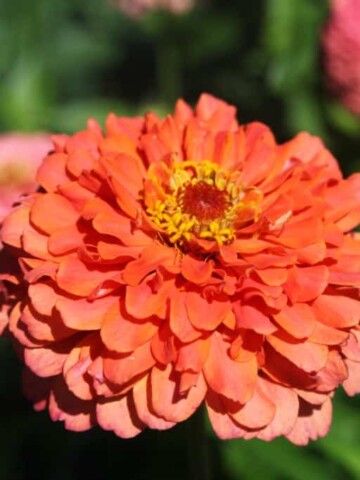
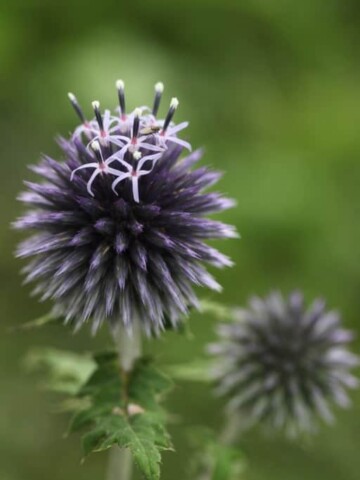
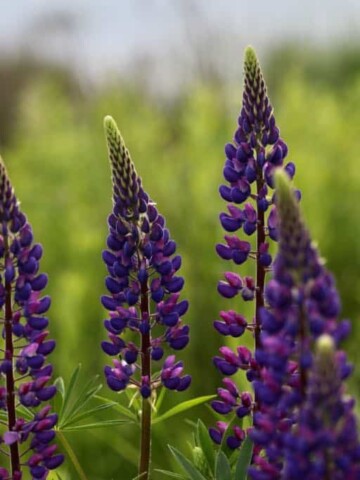
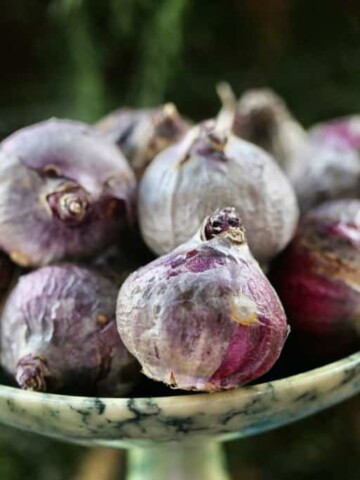
Leave a Reply